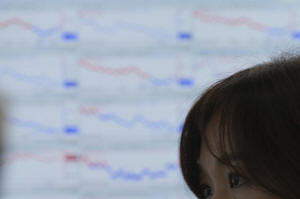World shares are mixed as markets take a breather after their recent
wild ride
[June 26, 2025] By
ELAINE KURTENBACH
BANGKOK (AP) — World shares were mixed on Thursday and the U.S. dollar
weakened as investors caught their breath following recent bouts of
volatility.
Traders were turning to U.S. updates on durable goods orders, jobs and
consumer spending and what say about how President Donald Trump’s higher
tariffs are affecting the economy, analysts said.
Germany's DAX surged 0.7% to 23,661.67. In Paris, the CAC 40 edged 0.1%
higher to 7,565.46. Britain's FTSE 100 also gained 0.1% to 8,729.71.
The future for the S&P 500 was up 0.3% while that for the Dow Jones
Industrial Average rose 0.2%. On Wednesday, the S&P 500 barely budged,
closing just 0.8% below its all-time high set in February. The Dow
dipped 0.2%, while the Nasdaq composite rose 0.3%.
Tokyo's Nikkei 225 climbed 1.7% to 39,584.58 as attention shifted to a
July 9 deadline for trade agreements to help stave off higher U.S.
tariffs imposed by President Donald Trump.
Japan's lead trade negotiator, Ryosei Akazawa, was due to visit
Washington for another round of talks, with 25% U.S. import duties on
Japanese vehicles a main point of contention.
Chinese markets were mixed. The Hang Seng in Hong Kong fell 0.6% to
24,325.40, while the Shanghai Composite index slipped 0.2% to 3,448.45.
In South Korea, the Kospi dropped 0.9% to 3,079.56 as traders sold
shares to lock in recent gains.
Australia's S&P/ASX 200 slipped 0.1% to 8,550.80.
Taiwan's Taiex gained 0.3% and the SET in Bangkok also gained 0.2%.

In the oil market, which has been the center of much of this week’s
action, crude prices have stabilized after plunging by roughly $10 per
barrel earlier this week.
Benchmark U.S. crude lost 10 cents early Thursday to $64.82 per barrel,
though it still remains below where it was before the fighting between
Israel and Iran broke out nearly two weeks ago.
Brent crude, the international standard, gave up 5 cents to $66.38 per
barrel.
[to top of second column] |

A dealer moves near the screens showing the Korea Composite Stock
Price Index (KOSPI), left, and the foreign exchange rate between
U.S. dollar and South Korean won at a dealing room of Hana Bank in
Seoul, South Korea, Thursday, June 26, 2025. (AP Photo/Lee Jin-man)
 A fragile ceasefire between the two
countries appears to be holding, at least for the moment.
In the bond market, Treasury yields held relatively steady, and the
yield on the 10-year Treasury eased to 4.27% from 4.30% late
Tuesday.
Yields had dropped a day earlier after the chair of the Federal
Reserve told Congress it is waiting for the right moment to resume
cutting interest rates. By lowering rates, the Fed could give the
economy a boost, but it could also fuel inflation.
Fed Chair Jerome Powell reiterated to a Senate committee Wednesday
that he wants to wait and see how Trump’s tariffs affect the economy
and inflation before committing to its next move. He added it's
possible that tariffs won’t increase inflation by very much.
Trump has pushed for rate cuts to help reduce interest costs the
federal government pays on its debt and he has sharply criticized
Powell for not reducing borrowing costs, calling him a “numbskull”
and a “fool,” adding to speculation that he will move to replace the
central bank's chair to seek more influence over the Fed.
That has helped pull the U.S. dollar lower.
Early Thursday, the dollar was trading at 143.79 Japanese yen, down
from 145.26 yen. The euro rose to $1.1739 from $1.1661.
“Traders smelled what this was, an open audition for for who can
promise the deepest cuts and the most pliant policy,” Stephen Innes
of SPI Asset Management said in a commentary.
All contents © copyright 2025 Associated Press. All rights reserved |